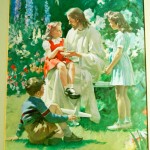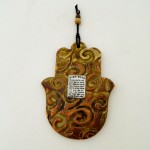by Elizabeth Dunbar
Religion and art have played significant roles in my life from a young age. I was born into a newly converted, non-denominational Christian household, my father and mother having converted from Catholicism and Judaism, respectively. My first memories of religion are evangelical in nature, but this quickly changed when my family became Catholic (for most of them, this was merely a re-entrance into the Church). I was five when my little sister and I were baptized, and my family has remained Catholic since then. But through all of this, my mom clearly held onto her Jewish identity.

A mezuzah that hangs on one of the doorways in our house. I picked this one up at the synagogue in Rome during my travels last year.
Growing up, we celebrated the Jewish holidays, Hebrew prayer books and copies of the Tanakh could be found in the house, and a mezuzah marked the entrance of our home. Looking back at my childhood, I am struck by various visual manifestations of each of these religions.
As a visual person, I have always been interested in discovering the art of these three religious institutions. Early exposure to a variety of religious art helped commence this journey. At a young age, I not only became acquainted with faith doctrines through images (it’s not a coincidence that most religious art was made for didactic reasons!), but also had a chance to observe similarities and differences in artistic representation between different windows into faith.

I had this poster in my room for years growing up. It was easy to imagine myself as the little girl on the lap of the risen Christ.
My first Bible, a children’s illustrated one, came from the Christian fellowship church. Jesus Christ was emphasized as the subject of many of the scenes I remember. Most of the illustrations featured children following Christ; thus, as a child-reader, I could relate to the stories in the same way. These images fostered a personal relationship with Christ as Lord and Savior, which is highly emphasized by Christian evangelical communities.
When my family became Catholic, new artworks and books, which visually emphasized devotion to Mary, the Mother of God, the Holy Family, and all the saints, could be found in our home. Suddenly, the emphasis of the images switched from a direct, personal relationship with Christ to a communal connection to the Trinity through the physical body of the Church – specifically, the saints.
In my baptism, I gained a family of believers connected to Christ, and, instead of going straight to Jesus in prayer, I could now intercede my prayer through various saints. Quickly, I developed strong connections to certain saints whose stories stirred me, and religious art strengthened this devotion.
Judaism is known for not depicting figures in art, harking back to the commandment forbidding idols. But, even without figures, images find their place in the religious life of the people. One of my favorites as a child was my mom’s chamsa necklace. The chamsa, a simple image of a hand which is also common to Islam, holds much significance. There are various interpretations of its meaning, but I was taught that it represents the hand of God. Chamsa comes from the Hebrew word hamesh, meaning five. The five fingers of the hand represent the five books of the Torah, the foundation of Jewish belief and life. My mother’s chamsa had two Hebrew letters in the middle of it, which form the word chai, or life. Thus, God is the creator of all life, and He holds us, His creatures, in His hand. This visual, and the symbolism it carries, fascinated me as a child.

Unique to my experience as a Catholic are holy cards. This is just a few of the many I have amassed over the years.
At a young age, I realized the strong effect visual art can have on a person’s beliefs. Going to college, I was interested in studying the strong connections between theology and art. Working with both the Art and Religious Studies departments at Seton Hall not only sharpened my knowledge of and ability to research these topics, but, more importantly, enhanced my understanding of the whole human person. Before pursuing undergraduate studies, my experience of faith and art came from a very personal place, but, during my time at Seton Hall, I was able to see my interests from a different, more universal scope. Classes like Medieval Italian history, art of colonial Latin America, and Catholic classics and interiority pushed my academic boundaries and taught me to look at the global reaches of my studies; faith and art are unique products of every culture. The intersection of faith and art affect every person on some level, and so the study of this area becomes a study of the human experience.
 About the author: Elizabeth Dunbar was born and raised in Thousand Oaks, California. She is the middle of 5 children in a Catholic homeschooling family, who grew up adhering to many of the traditions of her Jewish mother. After attending an all-girls’ high school (La
About the author: Elizabeth Dunbar was born and raised in Thousand Oaks, California. She is the middle of 5 children in a Catholic homeschooling family, who grew up adhering to many of the traditions of her Jewish mother. After attending an all-girls’ high school (La
Reina), Elizabeth uprooted to the East coast to attend Seton Hall. At Seton, she double-
majored in Art History and Catholic Studies. During her senior year, she researched and wrote a thesis concerning Eucharistic theology and devotion in 17th century Spain under the advisement of Dr. Anthony Sciglitano. She graduated summa cum laude in May 2011,
and then spent 12 months living and working in Annecy, France as an au pair. Elizabeth
has recently been accepted to a dual-degree graduate study program in Library
Sciences and Art History at the University of North Carolina- Chapel Hill.


